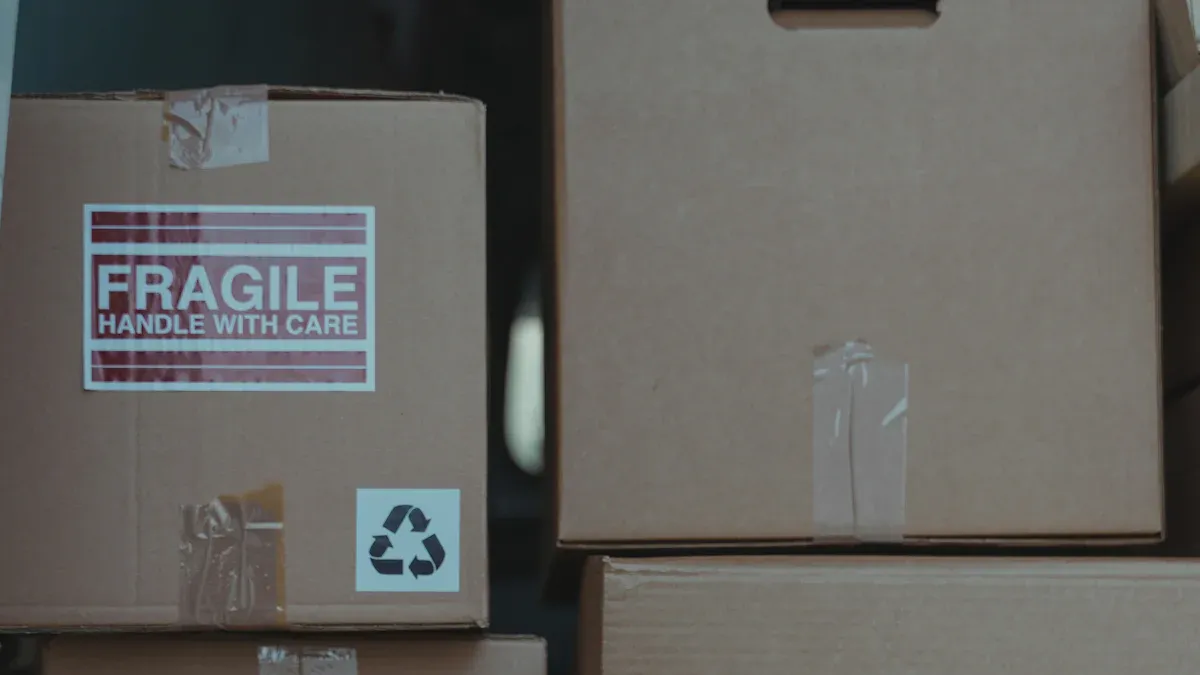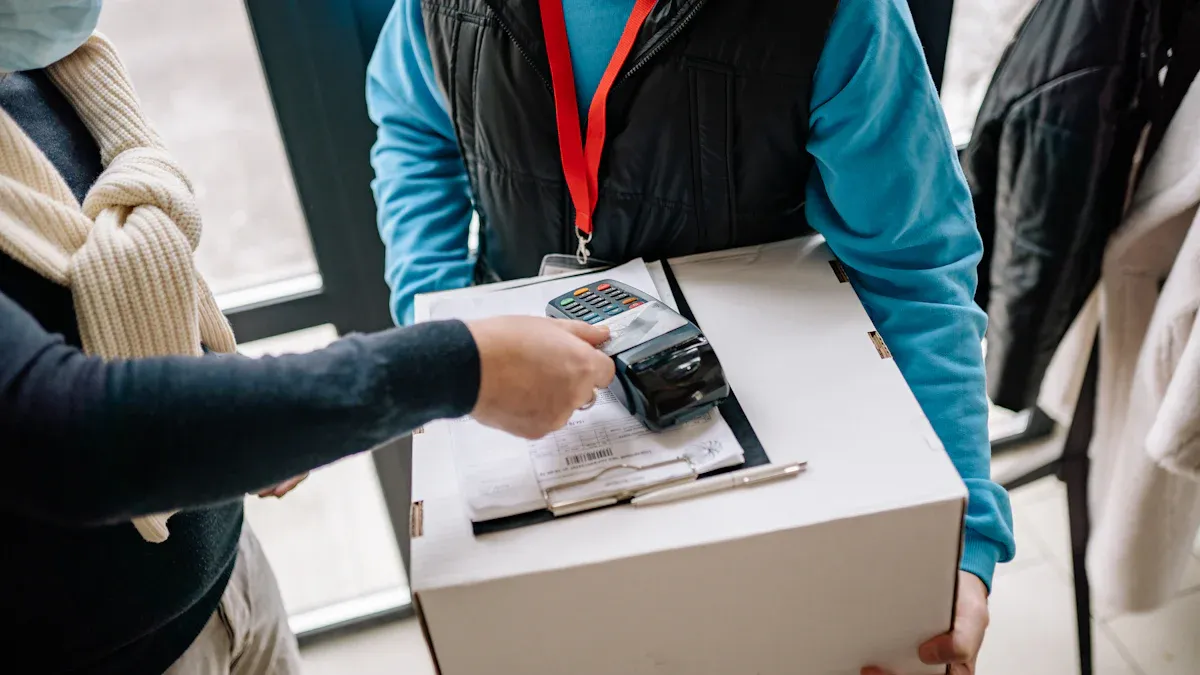Secure Cross-Border Shipping for Electronics in 2025

You want secure cross-border shipping for your electronics in 2025. The amount of cross-border shipping keeps going up. U.S. freight to Canada and Mexico was $144.8 billion in March. Computers and electronics are a big part of this number. Shipping electronics means you must follow strict rules. There are also risks with delivery. Fishgoo’s one-stop service helps you ship electronics securely. You need good partners, smart protection, and careful planning. This helps make secure cross-border shipping safe every time.
Key Takeaways
Pick strong packaging to keep electronics safe from harm. Use moisture-barrier bags and double boxes for extra protection.
Keep up with international shipping rules. Every country has its own rules, so check them before you ship electronics.
Make sure all shipping papers are filled out and correct. If you miss paperwork, your shipment can get stuck at customs.
Choose a trusted shipping partner like Fishgoo. They give strong packaging, tracking, and help with rules to keep your shipments safe.
Use real-time tracking to watch your shipment. This lets you fix problems fast and helps your package arrive on time.
Cross-Border Shipping Challenges
Risks for Electronics
Shipping electronics can be risky. Packages may break if packed wrong. Hot or cold weather can hurt sensitive parts. Rough handling can cause damage. Customs checks can slow down your shipment. Sometimes, customs look extra closely at your packages. Lithium-ion batteries need special care. They must be packed in a certain way. You have to follow safety rules for these batteries. Watch out for these common risks:
Damage from bad packaging
Very hot or cold temperatures
Bumps and drops during shipping
Customs checks and delays
Fire danger from lithium-ion batteries
Tip: Pick packaging that protects from drops and heat. This keeps your electronics safe.
Regulatory Hurdles
There are many rules for shipping electronics to other countries. Each place has its own rules. If you ship to the United States, you need to meet FCC rules for WiFi and Bluetooth. The European Union wants CE marking and REACH rules followed. These rules keep products safe and track chemicals. Here is a table showing how rules are different:
Region | Regulation Type | Required by Law | Notes |
|---|---|---|---|
United States | FCC | YES | Controls electronic devices like WiFi and Bluetooth. You must follow these rules. |
UL | NO | This is a choice, but it shows good quality. | |
RoHS | NO | You can use self-declarations for this rule. | |
European Union | CE | YES | You must have this mark to sell in Europe. |
REACH | YES | Controls chemicals in products, you must follow this rule. | |
WEEE | YES | Makers must mark packaging or products with this. | |
China | N/A | N/A | No special rules for electronics are listed. |
You also need to think about trade bans and export rules. Some parts, like chips, cannot be shipped to some places. You must watch for rule changes and check suppliers.
Tech Product Vulnerabilities
Electronics break easily. You must protect them from drops and water. Shipping lithium batteries needs extra care. These batteries can catch fire if packed wrong. Rules like RoHS and WEEE change how you buy and ship products. Fights between countries can stop you from sending some items. You need systems to check rules and make sure you follow them. Here are the main problems:
Regulatory Hurdle | Description |
|---|---|
Environmental Regulations | RoHS, REACH, and WEEE change how you buy and make products. |
U.S.-China fights make it hard to ship chips and mess up supply chains. | |
Export Controls | Some parts are banned, so you need other sources. |
Compliance Tracking Systems | You need good systems to watch for rule changes and follow them. |
Supplier Vetting | Checking suppliers helps you avoid trouble and keep your business safe. |
Note: Always check the newest rules before you ship electronics. This helps you avoid problems and keeps your shipments safe.
Secure Cross-Border Shipping Steps

Packaging for Shipping Electronics
You want your electronics to get there safely. You must pack them with care. The right packing materials help a lot. Moisture, static, and rough handling can hurt your devices. Here is a simple guide for the best ways to pack:
Packaging Method | Description |
|---|---|
Moisture-Barrier Bags | These bags keep out water and stop moisture damage. |
Double-Sealed Packaging | Use two layers and desiccant packets for more moisture protection. |
Double-Boxing | Put your device in a box, then put that box in another box. |
Anti-Static Materials | These stop static electricity from hurting small parts. |
Cushioning Techniques | Use foam or bubble wrap to stop bumps and movement. |
Tip: Always double-box expensive electronics. This keeps them safe on long trips.
Fishgoo offers extra services like stronger boxes and shockproof packing. You can pick these when you ship with Fishgoo.
Disassembly and Protection
You can lower damage risk by taking apart big or odd-shaped electronics. Wrap each piece by itself. Use the original box if you have it. This box fits your device best and gives the most protection. If you do not have it, use strong boxes with bubble wrap or foam.
Take apart items that are hard to pack and wrap each part.
Use the original box for the best fit and safety.
Fishgoo’s warehouse team helps with taking things apart and careful packing. They check your items and make sure they are ready for shipping.
Labeling and Documentation
Getting the paperwork right is just as important as packing. You need the right documents for shipping electronics. This helps your shipment get through customs and arrive without problems. Here is what you usually need:
Commercial Invoice: Lists what you ship, how much, and the value.
Packing List: Shows what is in each box and how it is packed.
Bill of Lading: Proves the shipping company got your goods.
Export License: Needed for some electronics, especially if restricted.
Electronic Export Information (EEI): Needed for shipments over $2,500 or with special rules.
Certificate of Origin: Tells customs where your electronics were made.
Importer Security Filing (ISF): Needed for ocean shipments.
Compliance Certificates: Show your electronics meet safety and environmental rules.
Bill of Lading Instructions: Tell the carrier how to handle your shipment.
Proforma Invoice: Used as a quote before you ship.
Note: Fishgoo’s team can help you get and check all your paperwork, so you do not miss anything.
International Electronics Shipping Compliance
You must follow the newest rules for international electronics shipping. In 2025, new rules make shipping electronics safer and more reliable. Here is what you need to know:
Regulatory Area | 2025 Enforcement Status | What It Means for You |
|---|---|---|
UN38.3 Testing | You must have a test summary for each shipment | More paperwork, but fewer delays |
UN 4G/Class 9 Packaging | Needed for anything with lithium batteries | Costs a bit more, but fewer insurance claims |
SDS Documentation | Must be up-to-date and match GHS standards | Check your documents are less than a year old |
PHMSA Isolation | Keep batteries 2 inches apart or use fire-proof dividers | Warehouses must follow these rules |
EU Battery Regulation | New tracking and digital passport rules | Get ready for more data checks in Europe |
Fishgoo keeps up with these rules. They help you follow every step, from testing to paperwork, so your electronics move easily across borders.
Choosing Reliable Partners
You need a trusted partner to ship electronics. The right partner keeps your shipment safe, on time, and follows all the rules. Here is what to look for:
Lots of experience and knowledge
Good technology for tracking and updates
Can handle big or small shipments
Good record for on-time delivery
Big network and strong system
Criteria | Domestic Suppliers | Cross-Border Suppliers |
|---|---|---|
Order Processing | Fast and automatic | Automatic, but depends on time zones |
Transit Time | 2–5 days, usually the same | 10–30 days, can change |
Customs Handling | Not needed | Always needed, can cause delays |
Last-Mile Delivery | Local carriers, easy | Mix of international and local, varies |
Fishgoo is a reliable partner. They use safe shipping, strong rule checks, and a global warehouse network. Their team helps you protect your electronics, follow every rule, and keep your customers happy.
Remember: Picking the right partner is the best way to avoid problems and make sure your electronics arrive safely.
Pre-Shipment Checklist
Safety and Compliance Review
Before you send electronics, check that everything is safe and legal. This helps you avoid delays, fines, or having your shipment sent back. First, look up the rules for the country you are shipping to. Every country has its own laws. You need to follow these rules. If you work with a freight forwarder who knows a lot, they can help you. They will explain the rules and help you fill out forms.
Here’s why this review is important:
What to Check | Why It Matters |
|---|---|
Follow all regulations and fill out paperwork | Stops costly mistakes and keeps your shipment moving |
Know the local laws | Makes sure your shipment meets the country’s requirements |
Get help from experts | Reduces errors and saves you time |
You also need to collect all the right documents. If you miss paperwork, your shipment can be delayed or stopped at customs. Here is a table of the most important documents you need:
Document Type | Description |
|---|---|
Packing list | Lists what’s inside, with sizes and weights |
Commercial invoice | Shows the value and details of your shipment |
Bill of lading | Proves your goods are with the carrier |
Certificate of origin | Tells where your items were made |
Export declaration | Needed for shipments over $2,500 from the US |
Insurance certificate | Proves your goods are covered during shipping |
Dangerous goods declaration | Needed if you ship batteries or other risky items |
Tip: Check every document twice before you ship. This keeps your shipment moving.
Final Steps Before Shipping
Now get your devices ready to ship. You want your package to arrive safely and pass customs easily. Use packaging that fits your items well. This stops them from moving and breaking. If the original box is weak, use a stronger box that meets shipping rules.
Label your boxes so people know what is inside. Put stickers like “Fragile” or “Electronic Device” on the box. Make sure customs labels are easy to see. If you need to, add more instructions for the carrier.
Here is a checklist for your last steps:
Add clear labels and handling instructions
Check that all customs paperwork is attached
Make last-minute changes if needed
Remember: Careful packing and clear labels help your electronics get there safely and on time.
Best Practices for International Electronics Shipping
Packaging and Insurance Tips
You want your electronics to arrive safely. Pack your electronics with care. First, save your data and turn off your devices. Take out batteries so they do not leak. Wrap cables and accessories by themselves. This stops them from getting tangled or broken.
Do not use packing peanuts. Pick anti-static bubble wrap or foam inserts. These keep your items safe from shocks and static. Seal every edge with water-resistant tape. If it is humid, use moisture barrier bags. For sensitive things, use anti-static bags.
Here are some easy ways to protect your electronics:
Put each item in an anti-static bag and wrap it with bubble wrap.
Use strong, double-walled boxes for heavy items.
Put heavy things at the bottom and fill empty spaces.
Label your box with “Fragile” and give handling instructions.
Remember insurance. Insurance rules change by country and carrier. Some plans only work in certain places or for some electronics. Fishgoo’s insurance covers more and gives higher limits. Insurance helps you worry less, especially for expensive shipments.
Fishgoo’s strong packaging and insurance keep your electronics safe from bumps and water. You can ship without worry.
Tracking and Delivery
You want to know where your package is. Real-time tracking helps you do this. Today’s tech lets you see your shipment at every step. GPS shows you where your package is right now. IoT sensors check the temperature and humidity. This keeps your electronics safe. API integration updates your tracking info on all platforms.
Here are some new tracking tools:
Technology | What It Does |
|---|---|
GPS | Shows where your shipment is right now |
IoT Sensors | Checks temperature and humidity in the package |
API Integration | Updates tracking info on shipping platforms |
Predictive Analytics | Tells you about possible delivery delays |
Blockchain | Keeps your shipment data safe from changes |
AI and ML | Finds good delivery routes and spots problems early |
Delays can happen. Customs checks, busy ports, and paperwork mistakes cause them. Always check your documents and work with a trusted partner like Fishgoo. Their tracking and help let you fix problems fast.
Tip: Use real-time tracking and check your paperwork. This helps your electronics arrive safely and on time.
You can send electronics to other countries if you follow steps. Use strong packaging to keep your items safe. Make sure your paperwork is correct. Track your shipment so you know where it is. Pick a trusted partner like Fishgoo. They use special packaging and safe warehouses. You can see your shipment at every step. Learn about new shipping rules and technology. This helps you avoid delays and keeps your electronics safe. Shipping rules change quickly, so keep learning. If you do, your packages will arrive without problems.
FAQ
How do you track your electronics shipment?
Fishgoo’s tracking tools let you see your package live. Log in to your account and go to “My Parcel.” You will get updates at each step.
What packaging should you choose for fragile electronics?
Use double-boxing and anti-static bubble wrap. Fishgoo has strong outer boxes and shockproof packing. These keep your devices safe from bumps and drops.
Can you insure your electronics shipment?
Yes! Fishgoo lets you add insurance when you ship. Insurance pays for loss or damage. You pick how much coverage you want for safety.
What documents do you need for customs clearance?
You need a commercial invoice, packing list, and bill of lading. Fishgoo helps you get these papers ready so your shipment passes customs easily.
See Also
Strategies to Enhance Your Global E-Commerce Logistics Efficiency
Navigating Chinese Online Shopping: Best Platforms and Shipping Tips
Key Global Shipping Solutions Every Beginner Should Know
FISHGOO Makes Buying Chinese Goods Easier for Shoppers in 2025
Five Compelling Reasons to Select Fishgoo for International Shopping


